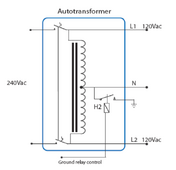LakeHouse
Solar Enthusiast
Looking for a sanity check on buying a Victron Autotransformer for an existing system, and then later repurposing it for a future system upgrade...
Current system is completely off-grid, 48Vdc with an AiO outputting 3.5kW of 120Vac. I would like to be able to run a heat-pump clothes dryer like this one, which has maximum power draw of 2500W, but requires 240V.
So my thought is to install a Victron 32A Autotransformer that would (currently) be used only to run the dryer. I realize that running a 2500W dryer on a 3500W AiO leaves me little overhead, but I'm not very concerned about that for now.
At some point down the road, the plan would be to replace the AiO with an separate SCC (this is purchased and just needs to be installed in the spring), and a 48Vdc, 5kW 230Vac Phoenix Inverter. The '230V' version of the Phoenix can be set to output 240Vac, which would be fed to a panel that would power the dryer (and any other future 240V loads) and the Autotransformer, which would now be repurposed to step-down the 240V to 120V to feed the existing 'main' distribution panel for the cabin.
Any see any glaring issues with this plan?
Current system is completely off-grid, 48Vdc with an AiO outputting 3.5kW of 120Vac. I would like to be able to run a heat-pump clothes dryer like this one, which has maximum power draw of 2500W, but requires 240V.
So my thought is to install a Victron 32A Autotransformer that would (currently) be used only to run the dryer. I realize that running a 2500W dryer on a 3500W AiO leaves me little overhead, but I'm not very concerned about that for now.
At some point down the road, the plan would be to replace the AiO with an separate SCC (this is purchased and just needs to be installed in the spring), and a 48Vdc, 5kW 230Vac Phoenix Inverter. The '230V' version of the Phoenix can be set to output 240Vac, which would be fed to a panel that would power the dryer (and any other future 240V loads) and the Autotransformer, which would now be repurposed to step-down the 240V to 120V to feed the existing 'main' distribution panel for the cabin.
Any see any glaring issues with this plan?



